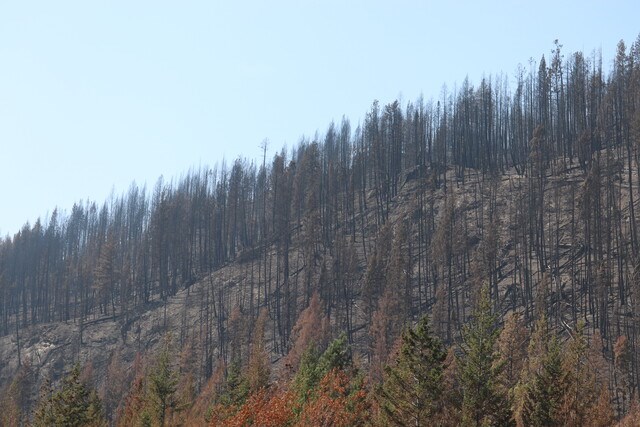As wildfires turn large swaths of forests into seas of charred spires, wildfire experts say the blackened blotches on the B.C. landscape can have a lasting effect reducing fire risk and severity.
Mike Flannigan, a wildfire researcher at Thompson Rivers University, said historic wildfire scars have less fuels available, meaning fires will burn less intensely and can be used as a break to slow the spread of a raging wildfire.
“Because it's lower intensity, fire management can manage it effectively and suppress it as opposed to a running crown fire, which they can’t,” Flannigan said.
“When things are really extreme, really hot, dry and windy, it will burn through, but it generally will be lower intensity, so you can still manage it more effectively than if it was in a forest.”
He said a recently burned area is unlikely to burn again for another 10 or 20 years, although this could take up to 50 years in wetlands or peatlands.
Fires create diversified landscapes
Neal McLoughlin, superintendent of the predictive services unit at the BC Wildfire Service's provincial wildfire co-ordination centre, said it's common for crews to use burned areas to cut off a spreading wildfire.
He said BCWS will map historic fires in front of a burning wildfire and look for ways to steer the fire into old burn scars, or conduct a burn operation in the scar to cut it off if there are available fuels. He said a burned area can also stop new fires from sparking.
Speaking anecdotally, he said previous wildfires in the Kamloops Fire Centre have left areas with reduced fuels that have stopped fires from spreading.
“There's areas in our Kamloops Fire Center which had some very large fire scars through the 2021 fire season and over the recent two year period, we have noticed we've been getting lightning strikes in those areas and we either don't have to respond at all, or if we do, the fires are quickly suppressed,” McLoughlin said.
He said a more diversified landscape broken up by historical fires and different vegetation types can offer an advantage to wildfire management when trying to control or steer an out-of-control blaze.
“When you have continuous landscapes with combustible fuels, that's the worst thing for wildfire management because the fire could really start anywhere and spread anywhere,” he said.
Burn scar effectiveness is conditional
McLoughlin said the effectiveness of a wildfire scar in mitigating new fires is conditional. He said it depends on how quickly a forest recovers after a wildfire — which he said is typically faster in the southern half of the province where shrubby fuels regenerate faster — the severity of the burnt area and moisture levels.
“It all depends on how they burned, if that same area burned under lower severity it might have left a lot of unburned fuels and so it may not have the same effect,” McLoughlin said.
“When we get very high drought conditions, like what B.C. has experienced over the last year, some of those areas can reburn.”
He said while a burn scar can offer an advantage to suppression efforts, it doesn’t necessarily create a barrier that will stop the fire entirely, and won't always reduce fire behaviour if conditions are dry enough.
He said in severe drought conditions, the entire landscape becomes available fuel.
“An older disturbance can also be combustible in a high drought year, and I've seen that. I've seen historic burns reburn in subsequent years and burn to white ash,” McLoughlin said.
Wildfires can bring benefits
According to McLoughlin, wildfires can help diversify and break up landscapes, create more diverse habitats for plants and animals, and can help regenerate forested areas impacted by insect or disease.
He said fire on the landscape can help reduce the risk of future wildfires.
“If we were to suppress all fires and prevent anything from burning — that's really been the model in western North America over the past several decades, and it's really led to conditions of having continuous conifer forests across the regions of the province that are available to burn,” McLoughlin said.
“Then you combine that with mountain pine beetles, or insect and disease that affect those large landscapes, and then you start layering on top of that climate change, and you've kind of got a really challenging recipe for disaster there.”
McLoughlin acknowledged wildfires can be highly impactful on communities and fire agencies, but said “beneficial fires” do occur.
“We've been through a really rough season, but there's also some advantages of having those burn scars now," he said.
"It's going to help reduce risk in certain regions.”





